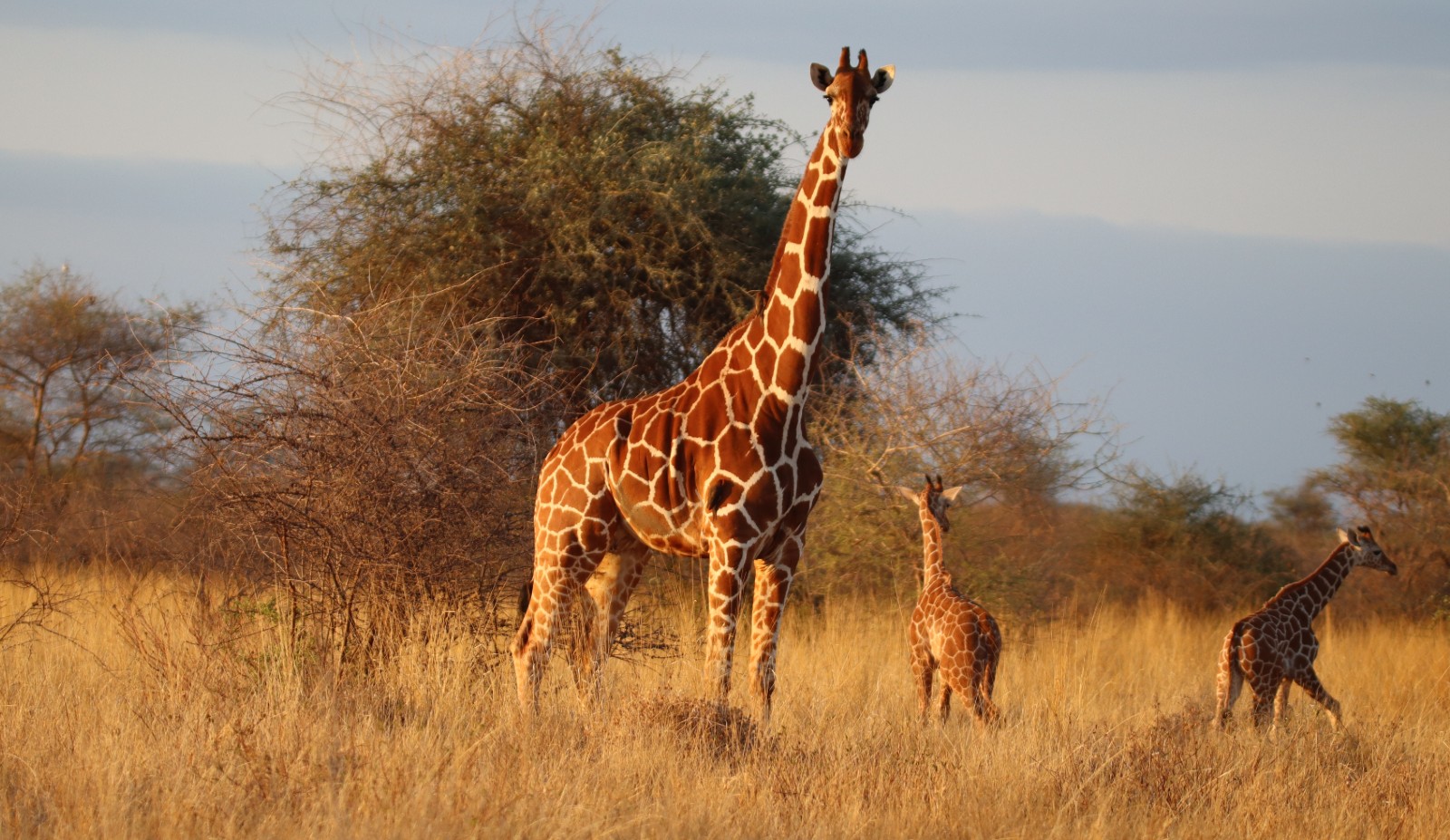Rare twin giraffes born in Kenya
18 December 2022
RARE TWIN GIRAFFES BORN IN KENYA
Born Free celebrates the arrival of extremely rare giraffe twins, born in our charity’s spiritual homeland of Meru National Park, in Kenya.

Born Free is delighted to report the birth of rare twin giraffes in Meru National Park in Kenya – the first ever recorded by our team in the park, which is 180 miles NE of Kenya’s capital Nairobi. Our Saving Meru’s Giants team – dedicated to protecting Meru’s endangered giraffes as well as elephants – is keeping a watchful eye.
“Our team is so excited to report our first ever giraffe twins in Meru, sighted within the Golo Campsite, in the eastern end of the park,” said our Saving Meru’s Giants Programme Manager Newton Simiyu – a remarkable Kenyan conservationist with ten years’ experience. “The mother’s name is Zarafa and it was wonderful to see her show great maternal care to the young ones as they ran around her, she was very attentive and affectionate.
“Only a handful of twin births have been documented in giraffes worldwide,” Simiyu continued. “The aim of our programme in Meru is to ensure a viable, freely roaming giraffe population and to mitigate threats including wire snares. Our locally employed Twiga* Team, in collaboration with the Kenya Wildlife Service, is committed to carrying out daily foot patrols to monitor giraffes and remove deadly and indiscriminate wire snares. We are working to make the habitat safe for giraffes to thrive, including Zarafa and her twins!”
The twins are reticulated giraffes, an endangered subspecies found almost exclusively in Kenya, with small populations in Somalia and Ethiopia. Instantly recognisable by their bright orange-brown patches surrounded by dazzling white borders, the subspecies is officially listed as Endangered on the International Union for the Conservation of Nature’s Red List and has undergone a 50% decline in just 30 years.
Today, fewer than 16,000 reticulated giraffes (Giraffa reticulata) remain in the wild and approximately 1,600 of these live in Meru – 10% of the entire global population. So, every single individual matters and Meru’s giraffes – including the new twins – are key to the survival of this threatened subspecies. Born Free’s Conservation Manager, Penny Banham highlighted the importance of the twins: “Giraffe twins are such a rare occurrence, especially in the wild, where the chances of both surviving are slim. But against all odds, we are thrilled that Zarafa and her twins are doing well, carrying on the story of reticulated giraffes in Kenya. They offer a glimmer of hope for the species, where the population has been in steady decline. Over their lifetime, these twins will inevitably face numerous challenges as their habitat, their home, continues to be degraded and deadly snares are laid in their path. But Born Free will be there, facing the challenges head on and making a brighter future for all giraffes.”
Giraffes in Meru are under terrible threat from poachers, with lethal wire snares being illegally set throughout the park. Although aimed at smaller herbivore species such as zebra and kudu, snares are indiscriminate, and giraffes sadly often fall victim. “Tragically, with their long limbs picking their way through the undergrowth, giraffes can be especially vulnerable,” explains Penny Banham. “Snares cause unbearable wounds, leaving giraffes permanently injured and much more susceptible to predation or slow death from their injuries. But our major new conservation programme, Saving Meru’s Giants, is determined to address the threats to giraffes as well as elephants. Our ultimate, practical vision is to create an environment for coexistence between people and these huge herbivores.”
After months of training by the Kenya Wildlife Service, Born Free’s brand new five-person Twiga Team is now hard at work in Meru, removing hundreds of deadly snares, gathering vital intel for our giraffe database and keeping giraffes safe. Since June 2022, 188 of Meru’s giraffes have been formally identified and recorded. This is a massive undertaking as the entire Meru Conservation Area is vast, around 1,930 square miles (5,000 square kilometers) in size. This critical database provides information on the structure of the giraffe population in Meru, helps us understand the movements of this species, and allows our team to monitor the health and condition of individuals. This information will be crucial in informing conservation action in the future.
Meru is Born Free’s spiritual homeland, where Elsa the lioness was returned to the wild in 1958 by conservationists Joy and George Adamson. With the help of funding from Born Free donors and adopters, our charity is determined to secure a future for the park’s wildlife, not least giraffes – this unique, ancient species unchanged for 1.5 million years.
You can help protect the new giraffe twins and support Twiga Team as they continue their inspiring conservation work by adopting our Giraffe Family and donating to our Saving Meru’s Giants Appeal.
*Swahili for ‘giraffe’
